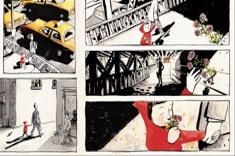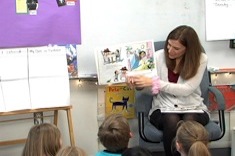When children are first learning to read, figuring out the alphabetic system is often so taxing that grappling with letters and sounds relegates meaning to the back burner. Although we understand why this happens, we know that because of it, many children develop imbalanced reading processes that can cause frustrating plateaus in their reading growth and development. When learning to read, meaning is the real goal, and should receive at least as much instructional attention as print, even with young readers.
However, because many books for young readers lack in-depth illustrations, showing readers how to read between the lines and recognize the subtlety of text can be difficult. This is one of the reasons we like to use wordless picture books with both primary students—the books balance their developing reading processes—and intermediate students—the books give them a different way to practice thinking deeply about a story. Here are a few particularly intriguing wordless books that we have recently discovered:
Sidewalk Flowers by Jon Arno Lawson, with illustrations by Sydney Smith (Groundwood Books, 2015), presents a touching story of a little girl’s trek through the city with her father, who walks with her as he obliviously talks on his cell phone. Throughout the walk, she picks dandelions and other flowering weeds from surprising places, such as sprouting out of the sidewalk or squeezing out through cracks in a brick wall under the subway. The most moving part of this truly touching story is that the little girl shares her flowers with an assortment of animals and people she meets along the way. The illustration uses color sparsely for the majority of the pages—painting in black and white as the rule, with the little girl’s hooded coat always in a contrasting red. By the end of the book, when the little girl reaches home and has almost run out of flowers, the pages are awash with full color. This is a tender, powerful, and beautiful book with a message for readers from young children to grown-ups. We really love this book!
Draw! by Raúl Colón (Simon & Schuster, 2014) is an artistic safari to Africa through the creativity and imagination of a young boy. From his bedroom in the city, our young guide—armed with his easel, pencil, and extra sandwiches—whisks us off to Africa. The boy encounters an elephant, who becomes his first subject and later carries him across the plains, where he encounters and draws various other emblematic animals. Raúl Colón’s wonderful illustrations feature color-filled drawing, where the imagined has a depth and detail as compelling as the reality in the book. The story begins and ends from the comfort of the boy’s familiar bed, and offers a lovely, circular, wordless adventure.
The Farmer and the Clown (Beach Lane Books, 2014), by two-time Caldecott winner Marla Frazee, is a delightful tale about a baby clown who falls off a circus train and is taken in by the farmer who finds him. This unlikely duo find that they have a lot to learn from each other about hard work, sharing, and friendship. The comic-strip-style illustrations, and sometimes graphic novel format, tell the story effectively against the background of a sparse landscape. This sincere, heartwarming, and beautiful story will put a lump in your throat.
Hello, Mr. Hulot by David Merveille (North South Books, 2013) is a wordless homage to film director and actor Jacque Tati’s famous character and film persona, Mr. Hulot. As in the films, the book recounts Mr. Hulot’s day-to-day experiences as seen through his naïve and comic point of view, offering lighthearted vignettes. Each two-page “story” includes one page with a series of colorful, comic-strip-style illustrations, and another full-page illustration that illustrates the story’s climax. In these vignettes Mr. Hulot always manages to prevail over the tricky situations in which he seems to find himself. This book tells many, many little stories, from Mr. Hulot fixing his sink to Mr. Hulot’s noticings at the zoo, and would provide rich, engaging prompts for classroom discussion or writing.
Flora and the Flamingo by Molly Idle (Chronicle Books, 2013) is filled with flaps and foldouts that demand interaction from the reader. The story is an illustrated ballet by a little girl and a flamingo, told in pink hues. The girl and flamingo cavort joyfully through the book, sometimes mirroring each other’s movements and acrobatics, other times interacting. Imitation being the sincerest form of flattery, the little girl’s mimicry of the flamingo—the little girl in a pink swimsuit and swimming fins—and the silent communication between the two is quite subtle and clever. Molly Idle’s experience as an artist for DreamWorks Feature Animation culminates in this book, and the central performances would elegantly translate to the big screen.
Unspoken: A Story From the Underground Railroad by Henry Cole (Scholastic Press, 2012) presents the tale of a girl living on a farm during the Civil War who discovers the staring eye of someone who is hiding in a pile of corn in her barn. Rather than tell her parents, she risks everything to keep the person hiding in her barn a secret and sneaks food to him or her (the illustrations never reveal the gender) every night. The girl never actually sees the hiding man or woman, but keeps the secret even when armed slave hunters come to the farm, offering a reward for information about a particular escaped slave. The monotone graphite illustrations lend a haunting and sometimes somber tone to a story that in the end is inspirational and uplifting.









